
Odds are you’re reading this blog post after arriving at the site for the first time and odds are, this is the first history of work shirts you’ve come across on the Internet. Admittedly, this is a bit of a rough sketch attempt I'll make below, but I want to go into some detail to explain how work shirt styles changed (and didn't) in various eras.
The late 1800s
The very first The Rite Stuff product I did was the Heracles work shirt and that was no accident: of all the ‘heritage’ clothing items, work shirts are my favorite and the Heracles design is among my favorite work shirt designs:


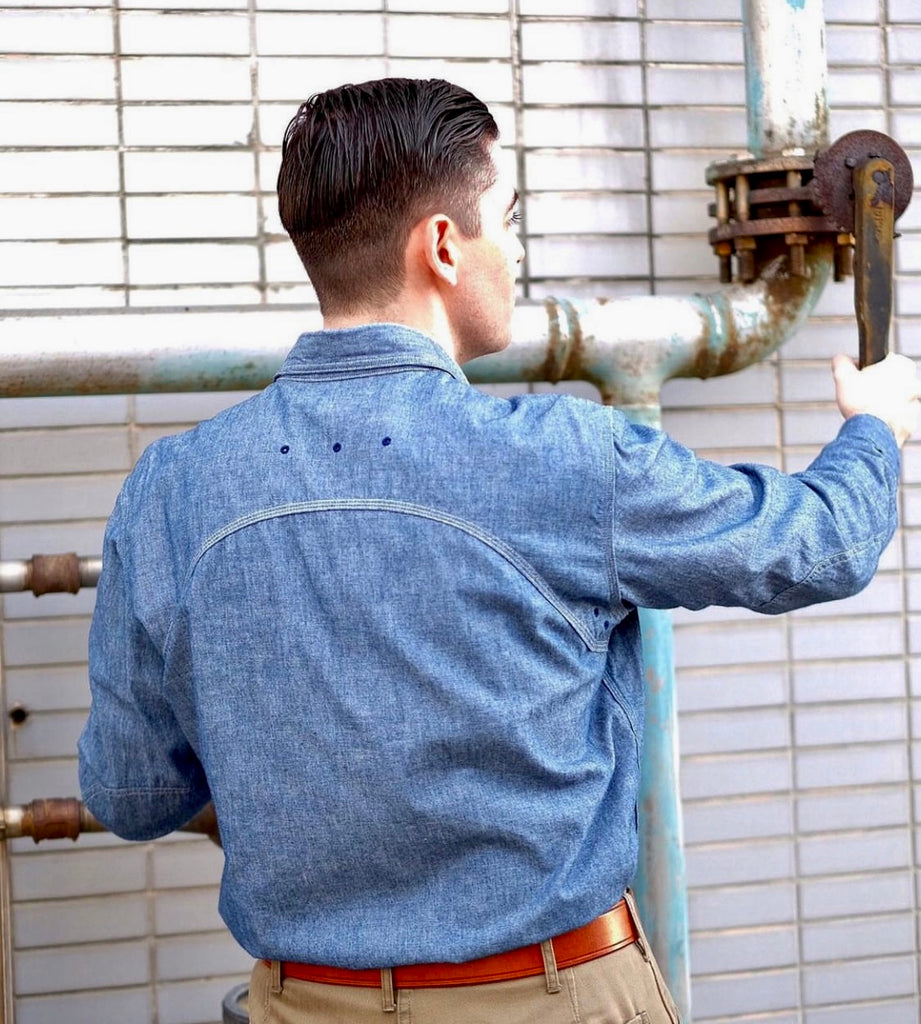
Where did this design come from, though? The earliest example I’ve found dates to two patents, both filed on May 4th, 1886:
The first is from Jacob Lederer of New York:

The second is from Isaac B. Keller of Lebanon, Pennsylvania:

Here's a better look at them:


Keller explains the design like so:
"The present invention has relation to certain new and useful improvements in shirts; and the object thereof is to provide means whereby the shirt is materially increased in strength around the shoulders or yoke, and insure its fitting much nicer, as well as more comfortable to the wearer."
It's very interesting that these two patents were filed by different men in different states but on the same day; I'm not sure what their relation was. Perhaps they were filing for a garment manufacturer in two different places, or maybe they were competitors and one caught wind that the other would file his patent?
At any rate, the 'Heracles design', the double scalloped yoke front and back work shirt seems to have been born on this date, though Keller notes in his patent application that "I am aware that it is common to provide a shirt in which a portion of the sleeve material extends up to the collar band; also that it is not new to extend a yoke portion out to the armhole of the shirt. My invention differs from either or both of these constructions." Could there have been an earlier shirt design that Keller and Lederer based theirs off of?
Whatever the case, the design continued and in 1899-1900 a similar design was patented again:

This patent for a double front, double back, double elbow work shirt, was filed by one S. Elbaum and differs in that the yoke extends onto the sleeve:

The 1900s-1910s
The turn of the century is an interesting time for workwear; along with the 1910s, there's actually a great deal we don't know about it, or at least less attention has been paid to it. That's because unlike the 1940s, 1930s, and even 1920s, there are fewer vintage pieces that have survived. Instead, a lot of what we know from this time period cones from catalogs, ads, photographs, patents, and the relatively fewer existing vintage pieces.
Let's take things back a little to 1897 with Sears Roebuck & Co.:

And a selection of shirts from Sears Roebuck in 1902:




And Montgomery Ward, also in 1902:

As you can see, catalogs from this time didn't always offer the most detailed illustrations, but we can glean some info from them and their descriptions, such as the fact that fabrics including chambray, sateen, wool, moleskin, and even Stifel’s indigo-dyed fabrics were being used. Shirts were essentially always pullovers, and you'd occasionally find esoteric styles and detailing, such as very large front plackets, shield fronts, lace-ups, etc.
At the turn of the century, work shirts mostly featured "chinstraps", a modern term for the extension neck band.
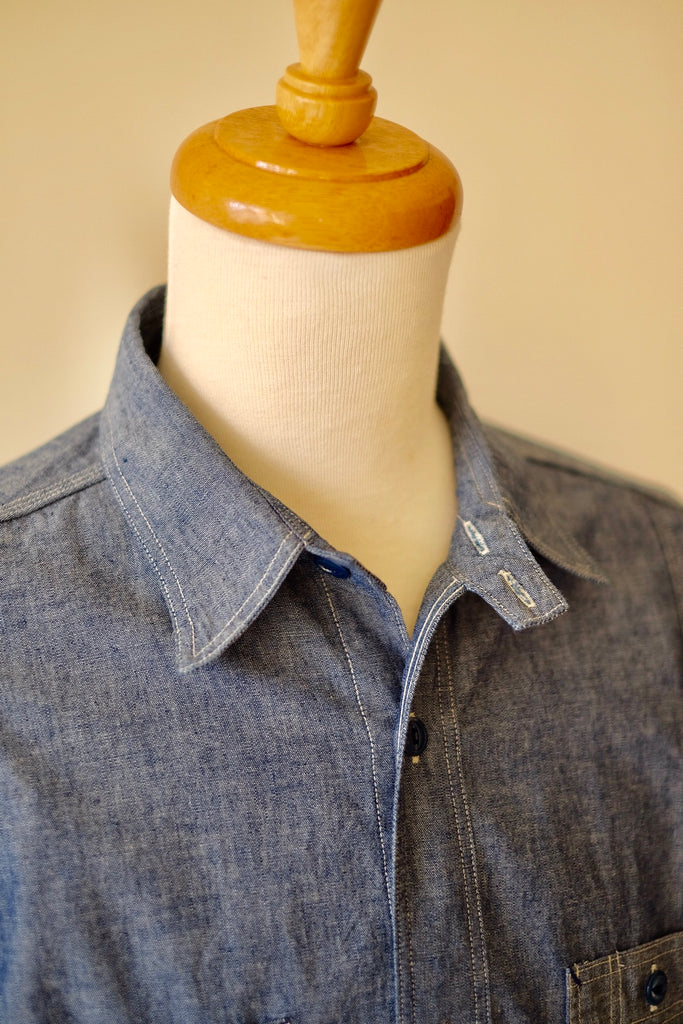

Extension neck bands on the Heracles and Bull Dog work shirts.
The purpose of the extension neck band was to keep the top button from pulling or sagging, to give the wearer a neater appearance when buttoning the shirt up, and to keep out the elements.
Shirts at this point were single-needle or double-needle stitched, labels were often cotton and printed (not woven tags, which were more common in dress, sport, and the hybrid dress-work shirt), back yokes tended to be very high and thin. Some of the construction quality from this time period could appear crude when viewing such items up close by today’s standards, but sewing methods and machines would improve rapidly.
Something interesting happened in 1904, in the Wyman, Partridge & Co. Wholesale Catalog out of Minneapolis: a new kind of front scalloped yoke work shirt appeared:

This is the earliest example I’ve seen yet of a scalloped double-front shirt, and something we won’t see again until 1912. Again, this would lead directly to the Heracles shirt.
Work shirts in started to change more at some point nearing 1910. In 1910 proper, we find the following pages from that year's Sears Roebuck catalog, including the birth of the mail-order business' now-famous line of Hercules clothing (at this point just a work shirt sub-brand):


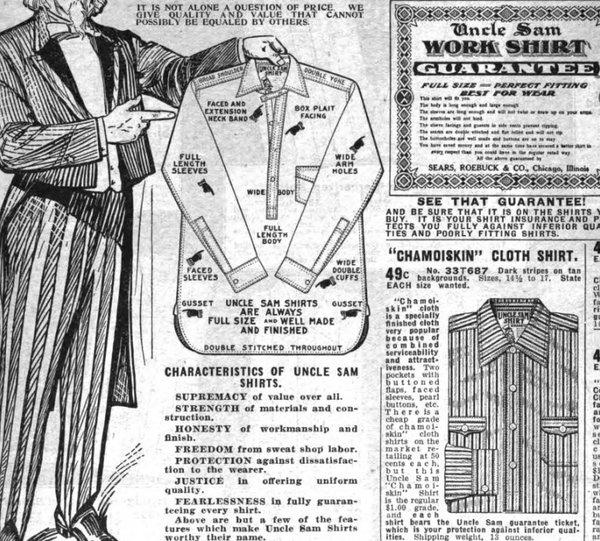

Two years later, in the 1912 Sears Roebuck catalog, shirt designs remained similar, except for a curious new entry:

This is the first documented example I can find of a scalloped back yoke and scalloped shoulder yoke combo in a work shirt. In this same year, Reliance Mfg. Co. of Chicago, founded by Milton F. Goodman, would patent a very similar design.
Here is the 1910s Reliance version on an undated box it would have come in; although we don't know the date for this, it carries a patent date of Dec. 24, 1912; this box is likely from the mid to late 1910s:

Image courtesy of e-Workers.
And we find the same images, crudely reproduced, on a newspaper ad clipping from 1914:

And then this 1914 ad from Reliance:
 Image courtesy of Yahoo! Auctions
Image courtesy of Yahoo! Auctions





This us the basis for our Heracles shirt, which differs in that it incorporates more 1930s elements:


Here we have a most interesting piece in the 1916 Montgomery Ward catalog:

The front yokes go under the collar, yes, but the back! It's almost a freedom sleeve at first glance, but it's because it's a triple layer of fabric, with the two top layers extending all the way down to the elbow.
Finally, we have the Sears Roebuck catalog of 1918:



In 1919, Reliance ran this ad for its various shirt sub-brands, from Milton F. Goodman to the new Big Yank brand, Black Beauty black sateen shirts, Honor Bright shirts for boys, and Old Faithful, the rarest and most difficult to find:



Another fun shirt from the period, note the shawl collar shirt below. These types of convertible collar shirts were also known as sport shirts and sold as short-sleeve items with sleeves that went down to the elbow:

The 1920s
With each passing decade we have more info to glean about work shirts. In the 1920s, the biggest single development is the introduction of the "coat style" shirt. This is what we think of today as a regular, button-front shirt, as opposed to a pullover. Of course, it wasn't a wholesale change overnight, so we still find catalogs that will offer pullovers in this decade, especially early on.
Here's Montgomery Ward in 1920:

The shirt on the left is coat style, whereas the shirt on the right is a pullover. Notice how the left-hand shirt still has a cutout in one pocket for a pocket watch.
Montgomery Ward continued down this path again in 1922:

And some other examples from the same catalog, this time with different, unique styling, including another type of ventilation hole:



Here's a vintage example of a deadstock, 1920s Brave Man chambray shirt by way of eBay; note the high, thin back yoke that was common in this era:
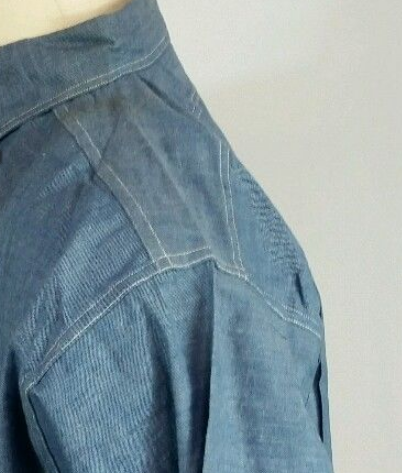

And another chambray pullover from the 1920s that appears to be a children’s sized shirt:

I can’t seem to find the image source for this one anymore, let me know who to credit.
Another very similar Peerless child’s pullover chambray work shirt from Overall Days:
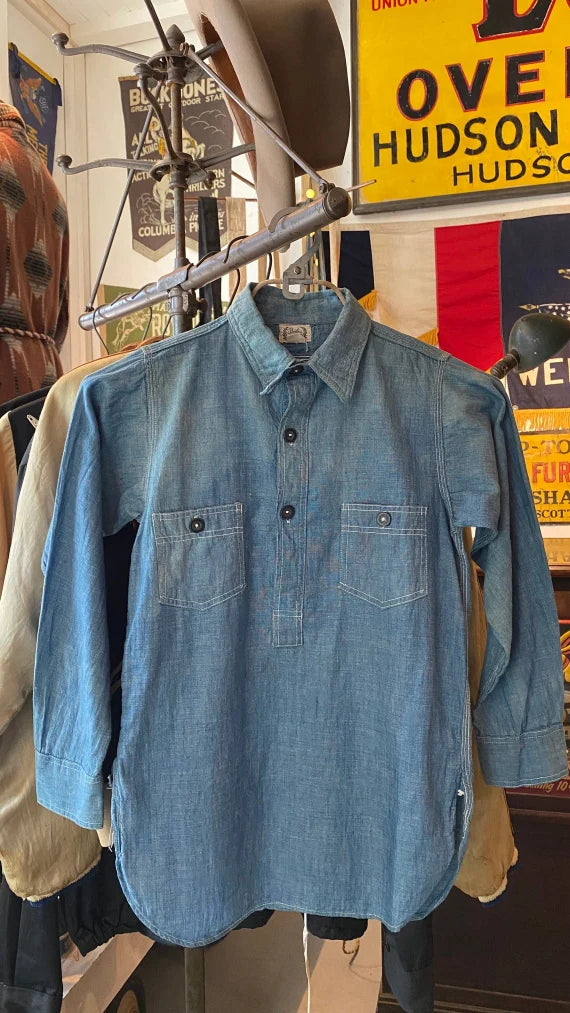
And a shirt box for a 1920s Roomy Richard chambray pullover, image courtesy of Speedway Sendai:

Wintertime calls for a heavier shirt, like this wool one from Pendleton that sold over at Cocky Crew Store; here we also see a woven tag, something that was gaining ground in the 1920s:

The following MWS Work Shirt in indigo warp and weft chambray is from an ad set that MWS ran from 1920-1921:

And more MWS ads from a magazine clipping in my personal collection:




Stifel’s polka dot was a popular fabric for work shirts at this point too, especially worn railroad men. Here’s a polka dot pullover in a photo from my personal collection:


I reproduced this shirt with wabash dot stripe fabric as the Bulldog work shirt:


In the 1920s, J.C. Penney heavily promoted their new Pay Day work shirts which were quietly rebranded as Big Mac work shirts, (possibly the real inspiration for the famous burger’s name?), leaving the Pay Day name for their overalls line:

Their answer to the Milton F. Goodman shirt was the Compass shirt:

Reliance would continue its advertising in the 1920s, here’s an ad from 1922 for the Milton F. Goodman shirt:


Here's a 1920s example of the Milton F. Goodman shirt in black sateen:

At the bottom of the ad, Reliance also mentions its Black Beauty shirt; I have two magazine clipping ads for this shirt in my personal collection, both undated but clearly from the 1920-25 time frame; here they are:

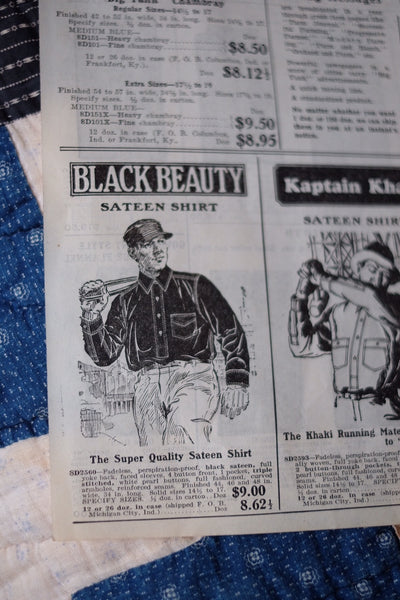
Reliance went on an advertising tear in 1923-24 so that timeframe provided lots of great illustrations, like these:

I’ve only seen two examples of a surviving Reliance Black Beauty shirts, here’s what’s essentially a dead stock one posted by Cocky Crew Store:


Here are some more Reliance ads from the same time frame.
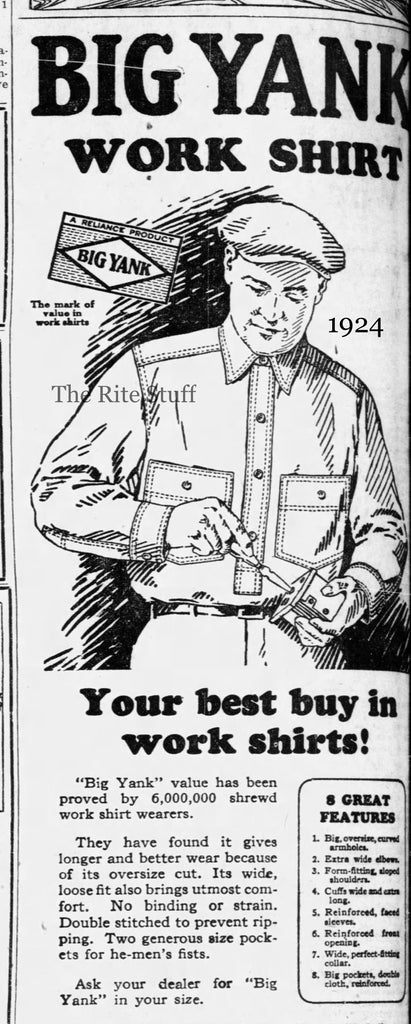
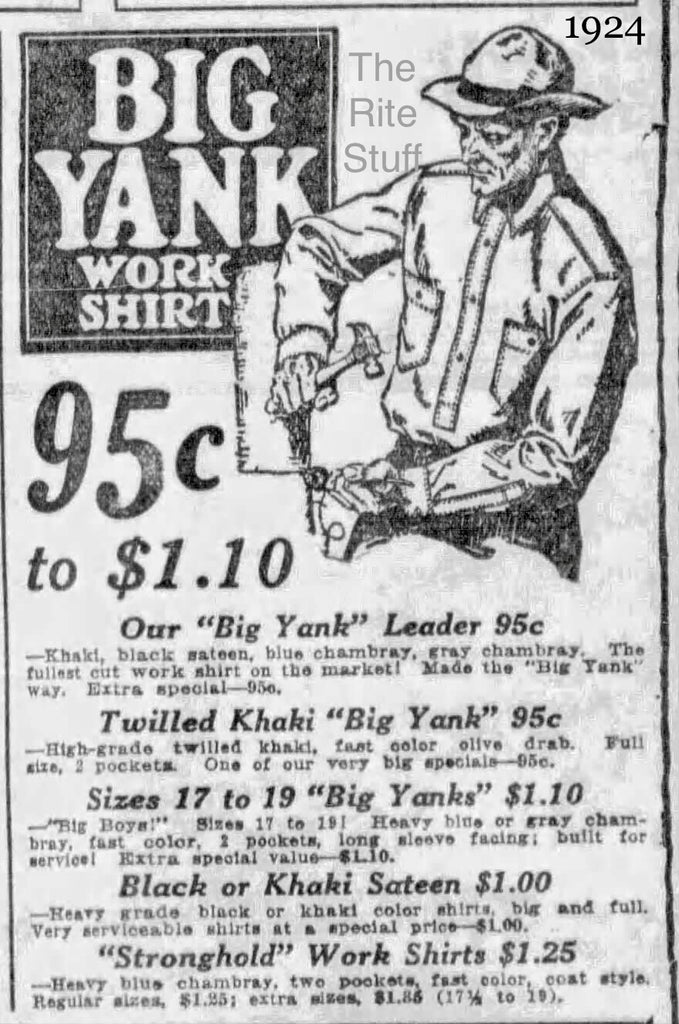
Here are photographic examples from the 1920s of workers wearing black sateen shirts, courtesy of David Patrick of Briar Vintage:


And some from A.G. Silvers:

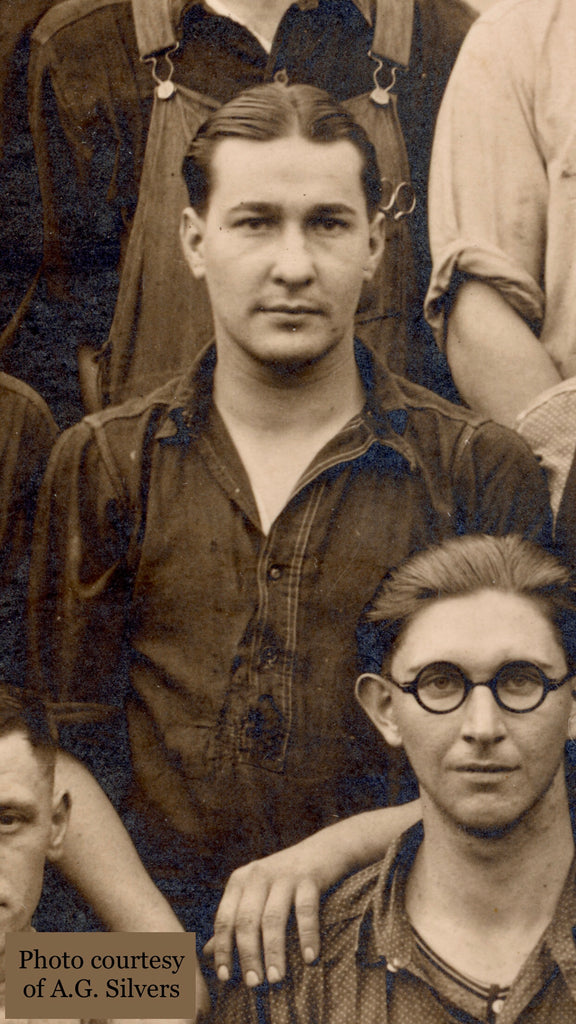
Here's two more glimpses of the MFG shirt again, one from 1922 and the second from an undated ad likely from the 1920s; note that the pocket shape has changed in the second image:


And another full-page that I have in my personal collection:


The Milton F. Goodman shirt was made in blue chambray, black and other colors of sateen, and khaki, that we know of.
Here are some photos of the few existing examples of the MFG shirt, in blue chambray and khaki jean:



Pretty soon we'd see another patent for a ventilated yoke shirt design that was filed in 1928-29 by John W. Champion:




We’re now reaching the end of the decade; in 1928-29, we can find this triple-stitching, scalloped-yoked no-vent holes work shirt from Montgomery Ward:

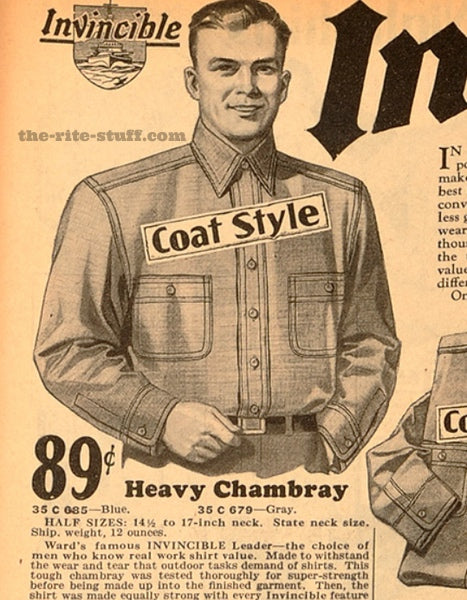
Click here to read Part 2: A Brief History of the Work Shirt - 1930-1940

Your article is very inspiring with high-quality content. We are sure that you will find additional useful information on our website. Come on, visit us at Jasa Konveksi Bandung and we can collaborate with each other.
Warm Regard.
Your article is very inspiring with high-quality content. We are sure that you will find additional useful information on our website. Come on, visit us at Jasa Konveksi Bandung and we can collaborate with each other.
Warm Regard.
Your website is very inspiring with high-quality content. We are sure that you will find additional useful information on our website. Come on, visit us at Konveksi Seragam Kerja and we can collaborate with each other.
Warm Regard.
I found an old RoomyRichards Chambray shirt with the air vent holes and double button chin strap. I was wondering if you could help but a decade to it not sure if there’s a way to post pictures.
Very interesting info on the workshirt history. Thank you so much for sharing. Love those old magazine ads too.